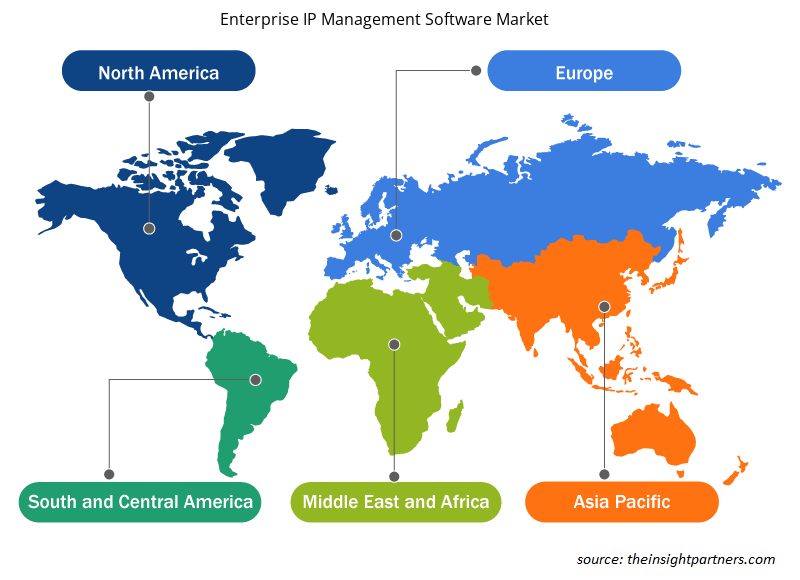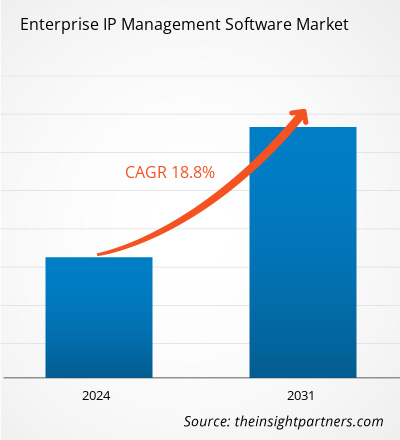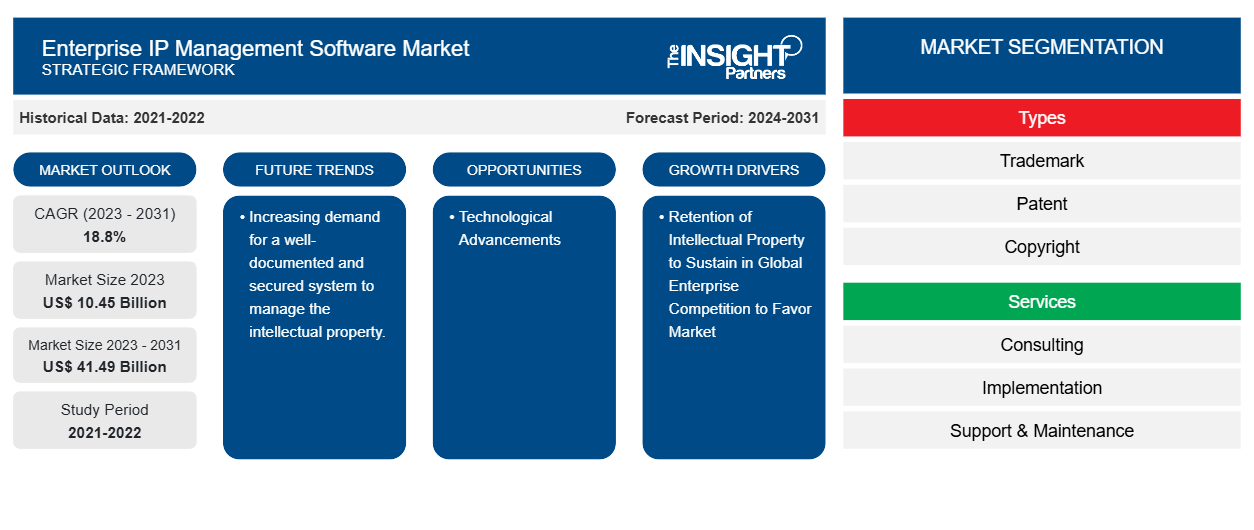Si prevede che il mercato del software di gestione IP aziendale raggiungerà i 41,49 miliardi di dollari entro il 2031, rispetto ai 10,45 miliardi di dollari del 2023. Si prevede che il mercato registrerà un CAGR del 18,8% nel 2023-2031.La conservazione della proprietà intellettuale per sostenere la concorrenza aziendale globale e il crescente numero di nuovi canali di distribuzione continueranno probabilmente a essere le principali tendenze del mercato dei software di gestione della proprietà intellettuale aziendale.
Analisi di mercato del software di gestione IP aziendale
Il mercato dei software di gestione IP aziendale è cresciuto ed è stato adottato a un ritmo considerevole negli ultimi anni e si prevede che queste tendenze continueranno negli anni a venire. I paesi in via di sviluppo nell'era della globalizzazione fanno affidamento sulla proprietà intellettuale (IP) per il loro progresso economico. Le economie in via di sviluppo dell'APAC stanno iniziando a riconoscere il valore della proprietà intellettuale (IP), la sua necessità e il modo in cui influisce sul commercio e sugli investimenti. Nonostante i numerosi vantaggi offerti dalle relazioni internazionali (IR), la maggior parte delle nazioni APAC non dispone delle procedure necessarie per emettere e far rispettare i diritti di proprietà intellettuale, il che causa ulteriori grandi perdite per le aziende.
Panoramica del mercato del software di gestione IP aziendale
Le aziende che possiedono marchi e brevetti o sperano di ottenerli utilizzano il software per la gestione della proprietà intellettuale. Il software per la gestione della proprietà intellettuale aiuta anche gli avvocati e gli studi legali di proprietà intellettuale nella pianificazione, esecuzione e risultato di depositi e contenziosi di proprietà intellettuale.
Personalizza questo report in base alle tue esigenze
Riceverai la personalizzazione gratuita di qualsiasi report, comprese parti di questo report, o analisi a livello nazionale, pacchetto dati Excel, oltre a usufruire di grandi offerte e sconti per start-up e università
-
Scopri le principali tendenze di mercato in questo rapporto.Questo campione GRATUITO includerà analisi di dati che spaziano dalle tendenze di mercato alle stime e alle previsioni.
Driver e opportunità del mercato del software di gestione IP aziendale
Conservazione della proprietà intellettuale per sostenere la concorrenza aziendale globale a favore del mercato
Le risorse di proprietà intellettuale sono strumenti importanti e adattabili per promuovere e mantenere la rivalità aziendale. La cosa più importante che la globalizzazione e la liberalizzazione del commercio hanno fatto è rendere tutte le aziende, anche le PMI , competitive su scala globale, anche se operano nel mercato locale di un paese. Le PMI hanno bisogno di un piano aziendale chiaro per rimanere competitive. Devono aumentare costantemente la produttività, abbassare i costi di produzione e migliorare la reputazione della loro linea di prodotti attraverso una varietà di mezzi, come investire in R&S, acquisire nuove tecnologie, creare design migliori e commercializzare con successo i loro beni.
Progressi tecnologici
I progressi tecnologici possono sconvolgere i mercati consolidati per il software di gestione della proprietà intellettuale aziendale, aprire nuove strade per il business e modificare il comportamento dei clienti. Le aziende devono tenere il passo con gli sviluppi tecnologici se vogliono rimanere competitive.
Analisi della segmentazione del rapporto di mercato del software di gestione IP aziendale
I segmenti chiave che hanno contribuito alla derivazione dell'analisi di mercato del software di gestione della proprietà intellettuale aziendale sono tipologie, servizi e utente finale.
- In base al tipo, il mercato del software di gestione IP aziendale è suddiviso in marchi, brevetti, copyright, design e contenzioso. Si prevede che il segmento dei marchi crescerà nel periodo di previsione.
- Per servizi, il mercato è segmentato in consulenza, implementazione e supporto e manutenzione. Si prevede che il segmento della consulenza crescerà nel periodo di previsione.
- In base all'utente finale, il mercato del software di gestione IP aziendale è suddiviso in BFSI , farmaceutico, automobilistico, aerospaziale e difesa, tecnologia informatica e istituti di ricerca. Si prevede che il segmento BFSI crescerà nel periodo di previsione.
Analisi della quota di mercato del software di gestione IP aziendale per area geografica
L'ambito geografico del report di mercato del software di gestione IP aziendale è principalmente suddiviso in cinque regioni: Nord America, Asia Pacifico, Europa, Medio Oriente e Africa e Sud America/Sud e Centro America. Il Nord America ha dominato il mercato del software di gestione IP aziendale. Le tendenze di adozione di tecnologie elevate in vari settori nella regione nordamericana hanno alimentato la crescita del mercato del software di gestione IP aziendale. Si prevede che fattori come l'adozione crescente di strumenti digitali e l'elevata spesa tecnologica da parte delle agenzie governative guideranno la crescita del mercato del software di gestione IP aziendale nordamericano. Inoltre, una forte enfasi sulla ricerca e sviluppo nelle economie sviluppate degli Stati Uniti e del Canada sta costringendo gli operatori nordamericani a portare sul mercato soluzioni tecnologicamente avanzate. Inoltre, gli Stati Uniti hanno molti operatori del mercato del software di gestione IP aziendale che si sono sempre più concentrati sullo sviluppo di soluzioni innovative. Tutti questi fattori contribuiscono alla crescita del mercato del software di gestione IP aziendale nella regione.
Approfondimenti regionali sul mercato del software di gestione IP aziendale
Le tendenze regionali e i fattori che influenzano il mercato del software di gestione IP aziendale durante il periodo di previsione sono stati ampiamente spiegati dagli analisti di Insight Partners. Questa sezione discute anche i segmenti di mercato del software di gestione IP aziendale e la geografia in Nord America, Europa, Asia Pacifico, Medio Oriente e Africa e America meridionale e centrale.

- Ottieni i dati specifici regionali per il mercato del software di gestione IP aziendale
Ambito del rapporto di mercato sul software di gestione IP aziendale
| Attributo del report | Dettagli |
|---|---|
| Dimensioni del mercato nel 2023 | 10,45 miliardi di dollari USA |
| Dimensioni del mercato entro il 2031 | 41,49 miliardi di dollari USA |
| CAGR globale (2023-2031) | 18,8% |
| Dati storici | 2021-2022 |
| Periodo di previsione | 2024-2031 |
| Segmenti coperti |
Per tipi
|
| Regioni e Paesi coperti |
America del Nord
|
| Leader di mercato e profili aziendali chiave |
|
Densità dei player del mercato del software di gestione IP aziendale: comprendere il suo impatto sulle dinamiche aziendali
Il mercato del software di gestione IP aziendale sta crescendo rapidamente, spinto dalla crescente domanda degli utenti finali dovuta a fattori quali l'evoluzione delle preferenze dei consumatori, i progressi tecnologici e una maggiore consapevolezza dei vantaggi del prodotto. Con l'aumento della domanda, le aziende stanno ampliando le loro offerte, innovando per soddisfare le esigenze dei consumatori e capitalizzando sulle tendenze emergenti, il che alimenta ulteriormente la crescita del mercato.
La densità degli operatori di mercato si riferisce alla distribuzione di aziende o società che operano in un particolare mercato o settore. Indica quanti concorrenti (operatori di mercato) sono presenti in un dato spazio di mercato in relazione alle sue dimensioni o al valore di mercato totale.
Le principali aziende che operano nel mercato del software di gestione IP aziendale sono:
- Anaqua, Inc.
- Chiarire
- WebTMS
- Proprietà intellettuale Cardinal, Inc.
- Patrix AB
- Flextarc
Disclaimer : le aziende elencate sopra non sono classificate secondo un ordine particolare.

- Ottieni una panoramica dei principali attori del mercato dei software di gestione IP aziendale
Notizie di mercato e sviluppi recenti del software di gestione IP aziendale
Il mercato del software di gestione IP aziendale viene valutato raccogliendo dati qualitativi e quantitativi dopo la ricerca primaria e secondaria, che includono importanti pubblicazioni aziendali, dati associativi e database. Di seguito è riportato un elenco degli sviluppi nel mercato:
- Nel febbraio 2023, Resurgens Technology Partners, una società di private equity focalizzata sul software, ha annunciato che la sua società in portafoglio, Wellspring, fornitore leader di software per l'innovazione e la gestione della proprietà intellettuale, ha completato l'acquisizione di IP Pragmatics, una società leader nella consulenza e nei servizi per il trasferimento tecnologico e la gestione della proprietà intellettuale.
(Fonte: Resurgens Technology Partners, comunicato stampa, 2023)
- Ad aprile 2022, Anaqua, il principale fornitore di tecnologia per l'innovazione e la gestione della proprietà intellettuale, ha annunciato i piani per il rilascio della sua nuova soluzione automatizzata di divulgazione delle informazioni come parte della sua offerta di gestione IP AQX per aziende e studi legali. Il nuovo sistema aiuterà i professionisti della proprietà intellettuale a risparmiare tempo e denaro semplificando e automatizzando il processo IDS.
(Fonte: Anaqua, Comunicato stampa, 2022)
Copertura e consegna del rapporto di mercato sul software di gestione IP aziendale
Il rapporto "Dimensioni e previsioni del mercato del software di gestione IP aziendale (2021-2031)" fornisce un'analisi dettagliata del mercato che copre le seguenti aree:
- Dimensioni e previsioni del mercato a livello globale, regionale e nazionale per tutti i segmenti di mercato chiave coperti dall'ambito
- Dinamiche di mercato come fattori trainanti, vincoli e opportunità chiave
- Principali tendenze future
- Analisi dettagliata delle cinque forze PEST/Porter e SWOT
- Analisi di mercato globale e regionale che copre le principali tendenze di mercato, i principali attori, le normative e gli sviluppi recenti del mercato
- Analisi del panorama industriale e della concorrenza che copre la concentrazione del mercato, l'analisi della mappa di calore, i principali attori e gli sviluppi recenti
- Profili aziendali dettagliati
- Analisi storica (2 anni), anno base, previsione (7 anni) con CAGR
- Analisi PEST e SWOT
- Valore/volume delle dimensioni del mercato - Globale, Regionale, Nazionale
- Industria e panorama competitivo
- Set di dati Excel
Report recenti
Rapporti correlati
Testimonianze
Motivo dell'acquisto
- Processo decisionale informato
- Comprensione delle dinamiche di mercato
- Analisi competitiva
- Analisi dei clienti
- Previsioni di mercato
- Mitigazione del rischio
- Pianificazione strategica
- Giustificazione degli investimenti
- Identificazione dei mercati emergenti
- Miglioramento delle strategie di marketing
- Aumento dell'efficienza operativa
- Allineamento alle tendenze normative























 Ottieni un campione gratuito per - Mercato del software di gestione IP aziendale
Ottieni un campione gratuito per - Mercato del software di gestione IP aziendale